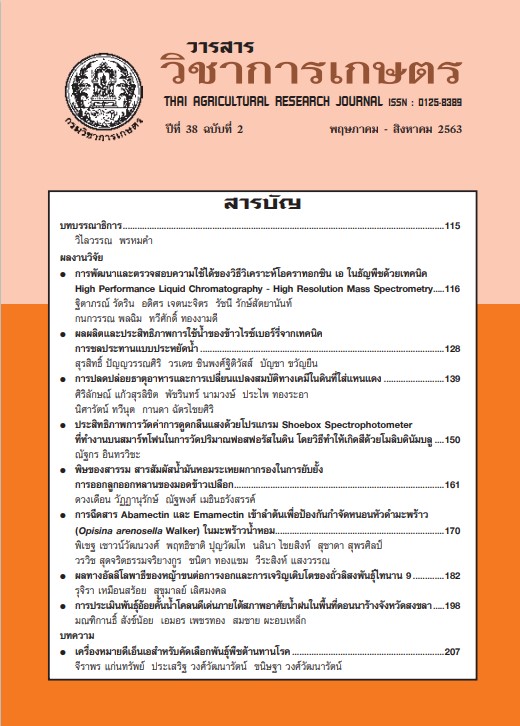การพัฒนาและตรวจสอบความใช้ได้ของวิธีวิเคราะห์โอคราทอกซิน เอ ในธัญพืชด้วยเทคนิค High Performance Liquid Chromatography - High Resolution Mass Spectrometry
DOI:
https://doi.org/10.14456/thaidoa-agres.2020.26คำสำคัญ:
ธัญพืช, HPLC-HRMS, การตรวจสอบความใช้ได้ของวิธี, อคราทอกซิน เอ, ข้าวสาลีบทคัดย่อ
งานวิจัยนี้มีวัตถุประสงค์เพื่อพัฒนาวิธีวิเคราะห์สารโอคราทอกซิน เอ ในธัญพืช ดัดแปลงจากวิธีมาตรฐาน AOAC (2016) 2000.03 โดยใช้เทคนิค High Performance Liquid Chromatography - High Resolution Mass Spectrometry (HPLC-HRMS) ปัจจัยที่ใช้ในการศึกษาภาวะที่เหมาะสมสำหรับวิเคราะห์สารโอคราทอกซิน เอ ด้วย HPLC-HRMS คือ โหมดไอออน (ไอออนบวกและไอออนลบ) และอัตราส่วนคงที่ของเฟสเคลื่อนที่ระหว่าง 0.1%formic acid in water (v/v) และ acetonitrile (20:80, 30:70 และ 40:60) จากการศึกษาพบว่า การใช้โหมดไอออนลบ และอัตราส่วนคงที่ระหว่าง 0.1% formic acid in water (v/v) และ acetonitrile ในเฟสเคลื่อนที่อัตราส่วน 30: 70 เป็นภาวะที่เหมาะสมสำหรับวิเคราะห์สารโอคราทอกซิน เอ จากนั้นตรวจสอบความใช้ได้ของวิธีวิเคราะห์เพื่อให้มั่นใจได้ว่าวิธีมีความถูกต้องและน่าเชื่อถือพบว่า ช่วงการใช้งานของการวิเคราะห์ (Working Range) อยู่ในช่วง 0.50 – 20 ไมโครกรัม/กก. ขีดจำกัดของการตรวจพบ (Limit of Detection) และขีดจำกัดของการวัดเชิงปริมาณ (Limit of Quantitation) มีค่าเท่ากับ 0.20 และ 0.50 ไมโครกรัม/กก. ตามลำดับ ความแม่นยำ (Accuracy) และความเที่ยงตรง (Precision) ของปริมาณที่วิเคราะห์อยู่ในเกณฑ์ยอมรับได้ (%Recovery 72.54 - 116.60, %RSD 13.10-13.69) ดังนั้นสามารถนำวิธีที่พัฒนาขึ้นมาไปใช้ในการวิเคราะห์หาปริมาณสารโอคราทอกซิน เอ ในธัญพืชได้โดยมีความแม่นยำในระดับที่ต่ำกว่าขีดกำหนดของมาตรฐานของประเทศผู้นำเข้า ปัจจุบันวิธีดังกล่าวได้ใช้เป็นวิธีมาตรฐานของห้องปฏิบัติการกองพัฒนาระบบและรับรองมาตรฐานสินค้าพืชกรมวิชาการเกษตร และได้รับการรับรองมาตรฐานห้องปฏิบัติการ ISO/IEC 17025 จากสำนักมาตรฐานห้องปฏิบัติการ กรมวิทยาศาสตร์การแพทย์
เอกสารอ้างอิง
Bertil Magnusson and Ulf Örnemark. 2014. EURACHEM Guide:The Fitness for Purpose of Analytical Methods, A Laboratory Method Validation and Related Topics, Second edition. Available from www.eurachem.org
Codex Alimentarius. 1995. Codex General Standard for Contaminants and Toxin in Food and Feed (CODEX STAN 193-1995). 41p.
Codex Alimentarius. 2018. GENERAL STANDARD FOR CONTAMINANTS AND TOXINS IN FOOD AND FEED CODEX STAN 193-1995. Amended in 2018
European Commision. 2006. COMMISSION REGULATION (EC) No 1881/2006 of 19 December 2006 setting maximum levels for certain contaminants in foodstuffs. Official Journal of the European Union. 364: 5-24.
European Commision. 2017. Guidance document on analytical quality control and method validation procedures for pesticide residues and analysis in food and feed SANTE/11813/2017. Implemented by 01/01/2018
George W. Latimer, Jr. 2016. Official Method of Analysis of AOAC International 20thedition. AOAC International. Chapter 49: 74 -76, Appendix F: 1-18
IARC (International Agency for Research on Cancer). 1993. IARC Monographs on the Evaluation of Carcinogenic Risks to Humans: Some Naturally Occurring Substances: Food Items and Constituents, Heterocyclic Aromatic Amines and Mycotoxins. 56: 489–599
JECFA (Joint FAO/WHO Expert Committee on Food Additives). 2008.Safety evaluation of certain food additives and contaminants. TRS 947-JECFA 68/59
Lund, F., Frisvad, J.C. 2003. Penicillium verrucosum in wheat and barley indicates presence of ochratoxin A. Journal of Applied Microbiology. 95: 1117-1123
WHO (World Health Organization). 2008. Ochratoxin A. Safety evaluations of certain 1 food additives and contaminants. WHO food additives series. 59: 357-429
ดาวน์โหลด
เผยแพร่แล้ว
รูปแบบการอ้างอิง
ฉบับ
ประเภทบทความ
สัญญาอนุญาต
ลิขสิทธิ์ (c) 2020 วารสารวิชาการเกษตร

อนุญาตภายใต้เงื่อนไข Creative Commons Attribution-NonCommercial-NoDerivatives 4.0 International License.
วารสารวิชาการเกษตร



